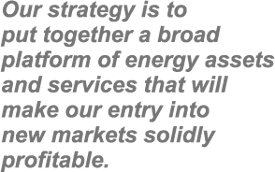Delivering a financially strong company
|
For 1998, the story of Duke Energy stretches from Brisbane, Australia, to Sable Island, Nova Scotia. It's a story of people blazing new trails around the world and of nurturing deep roots in the Carolinas and Texas.
The Duke Energy story is built on - and grows from - four basic strategies. In two years these strategies have gone from being almost uniquely ours to being the most imitated strategies in the energy industry. We're flattered. We're also inspired to execute those strategies better than any companies that might choose to copy us.
Let's look at these strategies and how the people of Duke Energy have taken hold of them and delivered. First, Duke Energy delivered a total shareholder return of 19.7 percent for 1998, and our market capitalization grew from $19.9 billion in 1997 to $23.3 billion in 1998. In a year of
accelerating change in the energy industry we have delivered a balanced and strong combination of growth in earnings, assets and capabilities. Our strategies help us tell that story in more detail. |

Richard B. Priory, Chairman, President and Chief Executive Officer |
Strategy: Provide superior electric service to the Carolinas. For the second straight year, Duke Power led the electric utility industry in customer satisfaction in the American Customer Satisfaction Index.
The data was collected by the National Quality Research Center, compiled by the University of Michigan, and the rankings were published in Fortune magazine.
Two of our coal-fired plants in the Carolinas were ranked the most efficient in the U.S. in 1998, according to Electric Light & Power magazine. For more than a quarter of a century, no company has been able to generate more electricity from a ton of coal than Duke Power.
Our retail electric operations in the Carolinas delivered solid earnings growth through increased sales, efficient, reliable generation, and a relentless drive to improve service and lower costs. Weather conditions in the second and third quarters combined with a strong regional economy to help us deliver record sales of 82,011 GWh. Earnings before interest and taxes (EBIT) for Electric Operations grew to $1,513 million, an 18 percent increase compared to 1997.
Strategy: Own and operate strategic energy supply assets worldwide. Our strategy is to develop or acquire significant power generation and natural gas assets, and to build a broad platform of assets to serve regions we have targeted for their growth potential.
In the Northeast U.S., we are redrawing the natural gas pipeline map with three projects: Maritimes & Northeast, Algonquin HubLine and Cross Bay pipelines. In this region where tens of thousands of megawatts of proposed new natural gas-fired power plants are still on the drawing board, Duke Energy Power Services will complete and place into service in 2000 power plants totaling more than 1,000 MW to serve the region's wholesale power markets.
In the Midwest U.S., we reached an agreement with CMS Energy Corporation to sell Panhandle Eastern Pipe Line Company and Trunkline Gas Company (Midwest Pipelines), along with natural gas storage and liquefied natural gas facilities. The market is characterized by plentiful supply and slower growth than we target for our assets.
CMS Energy Corporation will pay $1.9 billion and assume $300 million of Panhandle Eastern Pipe Line Company debt, making the transaction worth $2.2 billion. Absence of the Midwest Pipelines will reduce near-term earnings growth somewhat, but we will direct the capital to other business opportunities that can deliver higher rates of return long term. EBIT for Natural Gas Transmission grew to $702 million in 1998, up from $624 million in 1997.
 Low energy commodity prices in 1998 created ongoing opportunities for Duke Energy to acquire other strategic assets. Low crude oil prices kept strong downward pressure on prices for natural
gas liquids, which is Duke Energy Field Services' key energy commodity. EBIT fell to $76 million for 1998, compared with $157 million for 1997. Those same market conditions, however, opened up opportunities for us to acquire and enter into purchase agreements for natural gas gathering, processing and fractionation assets. The biggest of these was our announced $1.35 billion purchase of assets from Union Pacific Resources. In a consolidating industry, Duke Energy emerged as a clear leader in 1998. Low energy commodity prices in 1998 created ongoing opportunities for Duke Energy to acquire other strategic assets. Low crude oil prices kept strong downward pressure on prices for natural
gas liquids, which is Duke Energy Field Services' key energy commodity. EBIT fell to $76 million for 1998, compared with $157 million for 1997. Those same market conditions, however, opened up opportunities for us to acquire and enter into purchase agreements for natural gas gathering, processing and fractionation assets. The biggest of these was our announced $1.35 billion purchase of assets from Union Pacific Resources. In a consolidating industry, Duke Energy emerged as a clear leader in 1998.
Internationally, we are targeting Asia Pacific, Latin America and Europe. As in the U.S., our strategy is to put together a broad platform of energy assets and services that will make our entry into new markets solidly profitable. Our goal is to build regional energy businesses encompassing much of the energy value chain.
A good example is in Australia where we completed or announced acquisitions of the Queensland Gas Pipeline and Australian-based energy marketing operations; the Eastern Gas Pipeline which is under development; and BHP Energy's power generation assets and its ownership interest in the Goldfields Pipeline.
In Latin America, the Aguaytia Energy Project in Peru began commercial operation in 1998. By fully integrating natural gas and electric systems it serves as a model for how similar projects will be developed going forward.
We are in the early stages of developing our strategy for entry into the European market. The combination of privatization of energy assets, and the strong trading and marketing potential of this area make it an attractive market.
Overall, the growth and performance of our domestic and international asset base increased EBIT for our Global Asset Development group from $5 million for 1997 to $80 million for 1998.
Strategy: Supply and trade multiple forms of energy. One of our goals is to rank among the top
marketers of both natural gas and electricity in the U.S. and Canada - and to rank among the most profitable. In the second quarter of 1998, unprecedented volatility in U.S. power markets caused several major marketers to exit the business. Duke Energy Trading and Marketing produced strong growth in volumes and record EBIT, which grew from $44 million for 1997 to $122 million for 1998.
In the Canadian Maritimes Provinces, Duke Energy Marketing, the Canadian arm of Duke Energy Trading and Marketing, signed contracts with three of the region's leading industrial customers for gas supply contracts totaling more than 97 million cubic feet per day. By bringing both the natural gas delivery assets of the Maritimes & Northeast Pipeline and marketing capabilities to this market, we can provide cost-effective services, and be a most formidable competitor.
This illustrates an important aspect of our "supply and trade" strategy: We call it "leveraging" our assets and capabilities. For example, Duke Energy Power Services assumed ownership and operation of more than 2,600 MW of power generation facilities in California during 1998, while Duke Energy Trading and Marketing
managed the supply of natural gas fuel and marketed the megawatt-hours generated by the facilities.
Strategy: Provide energy-related products and services worldwide. DukeSolutions was created in 1997 to provide integrated energy services for large energy users across North America. Their mission - to be the premier business-to-business retail energy services provider. Consistent with that goal, DukeSolutions established a strong presence in Canada and the U.S. They delivered on a promise to be profitable for the fourth quarter and built an excellent foundation for future profitability by signing more than 24 contracts with a future revenue stream of $1.2 billion.
Duke/Fluor Daniel signed new contracts worldwide for power plant engineering, procurement and construction, as well as significant operations and maintenance contracts. Duke Engineering & Services began construction of a major renewable energy power project in Mauritius, completed a major component switch-out in a U.S. nuclear station and helped bring electric service to 300,000 South Africans. Other Energy Services EBIT was $10 million in 1998, down from $18 million in 1997.
Going forward: The strategies help tell most, but not all, of the story. The rest of the story springs from our commitment to our shareholders - our commitment to deliver growth in shareholder value.
We continue to target annual growth in earnings per share of 8 to 10 percent. In 1998 the Duke Energy Board of Directors voted to maintain the current annual dividend rate of $2.20 per share until earnings growth reduces the payout ratio to 50 percent of earnings. This will help provide the capital with which we will produce growth in earnings, in stock value and total shareholder return.
Virtually all of our businesses are capital intensive, and it is critical that we maintain the financial strength to take advantage of the "windows of opportunity" that the world's dynamic energy markets open to us.
Our goal is to have all systems "year 2000 ready" by mid-1999. Our program also extends to our suppliers, and we are working with the electric utility and natural gas industry groups to ensure safe, reliable energy supplies and services.
We continue to build the best team in the energy business. In 1998, W.W. Johnson and Buck Mickel retired from our Board of Directors, after long and distinguished service to our corporation. We will miss their valuable counsel. From our Policy Committee, Paul Anderson and Jim Hackett departed to lead other companies, and we gratefully acknowledge their contributions in making the merger to create Duke Energy Corporation one of the most effective on record. Through our industry leadership we are well positioned to recruit strongly from the best talent in the industry. Our team has been strengthened by the addition of Harvey Padewer, who has joined the Policy Committee as Group President of Energy Services. He brings extensive experience, encompassing electric power and gas pipeline industries, and a strong track record in business development.
We are able to recruit people of this caliber because of the reputation of the entire Duke Energy team. Fortune magazine's annual rankings of America's Most Admired Companies reflect a nationwide consensus of business leaders and financial analysts, and this year the performance of our team made Duke Energy the most admired company in the industry sector of electric and gas utilities. When the Financial Times of London surveyed CEOs around the world they ranked us as the world's most respected utility company. These accolades have been earned by, and belong to, each and every member of our team. When Electric Light & Power magazine named Duke Energy "Utility of the Year" that applied to the people who can build massive energy projects around the world and to the people who can provide reliable, responsive and friendly service to a homeowner in the Carolinas.
There are few companies in the world today that can do all of this. Our commitment going forward is that none will do it better. For 1999, our commitment to our customers and to our owners comes down to one simple statement: We'll deliver.
Rick Priory
Chairman, President and Chief Executive Officer
February 12, 1999
|